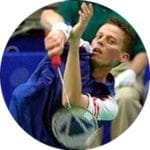When I played in halls with big drifts I’d always …

Richard Vaughan
Lose more than I won! 🙂 🙁
Why?
Not sure why, in general, the huge stadiums would be Super Series level events where I would be up against tough opponents. So it was difficult from the start.
I guess I am talking about significant drifts like in Singapore and China where the aircon was a huge factor. Most of the European large halls I'd played in had minimal drift when compared to Asia.
Undoubtedly the larger the drift the more significant the skill level increases to maintain play at a high level etc. and this needs to be practiced almost on a daily basis.
Sorry, I could you any exciting tips other than get used it to as soon as you can.

Ben Caldwell
Think about testing shuttles as it will help
As a player, I didn’t play enough in big halls so when I did I was quite slow to adjust to the drift resulting in too many mistakes usually hitting long of the opponent's backline.
As a coach, I advise getting as much practice in the hall as possible, listening carefully to all feedback from players and coaches about the conditions, watching others, and see how they deal with the conditions.
Use all the information sources you can. Carefully testing the shuttles and looking for drift is a good start.

Tracey Hallam
Use grip power and stay alert
Really pay attention to which the way the drift is especially when changing ends.
To confirm that I would sprinkle grip powder on my racket just to see which way the dust was going. Yes, it can be that much of a drift even at court level.
Be careful, the drift isn't always as you think, it can vary!
I used to try to work out not just which way the drift was, but how it affected the flight of the shuttle based on the height of the shot.
For example, some halls have a very strong drift when playing flat but not as much when you're hitting high lifts or clears.

Martyn Lewis
Consider trying these 2 things
Simply concentrate more!
Alongside this, I would have my rackets strung 1-2lbs less (normally 1) to help with control and then think of tactics and how to play, to best help me against my opponent.
Use a number of strategies
We haven't played in too many - Singapore Open and the All England being stand outs. It is always important to practice in the hall before you play to get used to the playing conditioning, but especially important with a big, drifty hall. Having said this, conditions can dramatically change from day to day so you have to be prepared to adapt!
Usually, you will talk to fellow players or teammates that have played before you about how the area is playing. This will then form part of your tactics going into the match!
Of course the more you play in these situations the more you get used to it - that's not great advice though as you can't take it away and implement it straight away!
It's sometimes easy to over analyse the drift and let it distract you from thinking clearly in other areas of your game.

Daphne Ng
I'd tell myself it's just a distraction that I must deal with
Be aware of it and study the direction of the draft, channel the mind positively, think about what game plan should be used to your advantage.
Distractions will always be there, to be a peak performer in sports, one must be able to adapt and respond to situations the fastest they can.
Think about playing 'Centre Badminton'
Try not to worry as this is not something you can control.
This is easier said than done. Some people are able to deal with drifts quite well and others aren’t. In some cases, you just have to play 'centre badminton'.
If drifts are not something you’re used to this sometimes is the only way. It sounds really simple and you may think ‘I can’t just hit it down the centre for the whole match’.
But it can be a way to build confidence to them wider your margins. There have been many times I have used this tactic. With drift or without drift.

Peter Briggs
I concentrate on assessing my lifts
When I play in halls with a big drift I always spend a large amount of time practicing my lifting, high lifts flat lifts etc these will give you a great idea of how the drift is working on each side of the court.
I've played in many halls where you can only high lift from one side because flat lifts will fly out the back. This also plays into defensive styles, how good are we when the drift speeds up our opponents smash from the other side of the court? Sometimes we have to play defensively on one side and hyper aggressively on the other.
I've even played in hall where a short serve (Mens Doubles) will land 6 inches short of the line because of the drift!
Thanks to everyone for their time and considered thoughts
If you'd like to join this expert team and start sharing your knowledge, send me a message and I'll send you some questions

Don't forget to click here to see a list of all the questions







